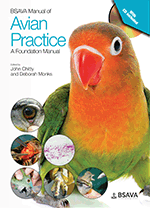
Full text loading...

Many birds are social animals with a diverse range of communication tools. Unfortunately, the subtleties of avian behaviour are often lost on many owners despite deep affection for their avian pets. This chapter will provide veterinarians with the tools to give much needed guidance in this area. Case examples: Finches flying frantically when disturbed; Galah ‘aggression’ towards family members; Bird–owner misunderstanding; Galah reluctant to ‘step up’.
Behaviour, Page 1 of 1
< Previous page | Next page > /docserver/preview/fulltext/10.22233/9781910443323/9781910443323.5-1.gif

Full text loading...







